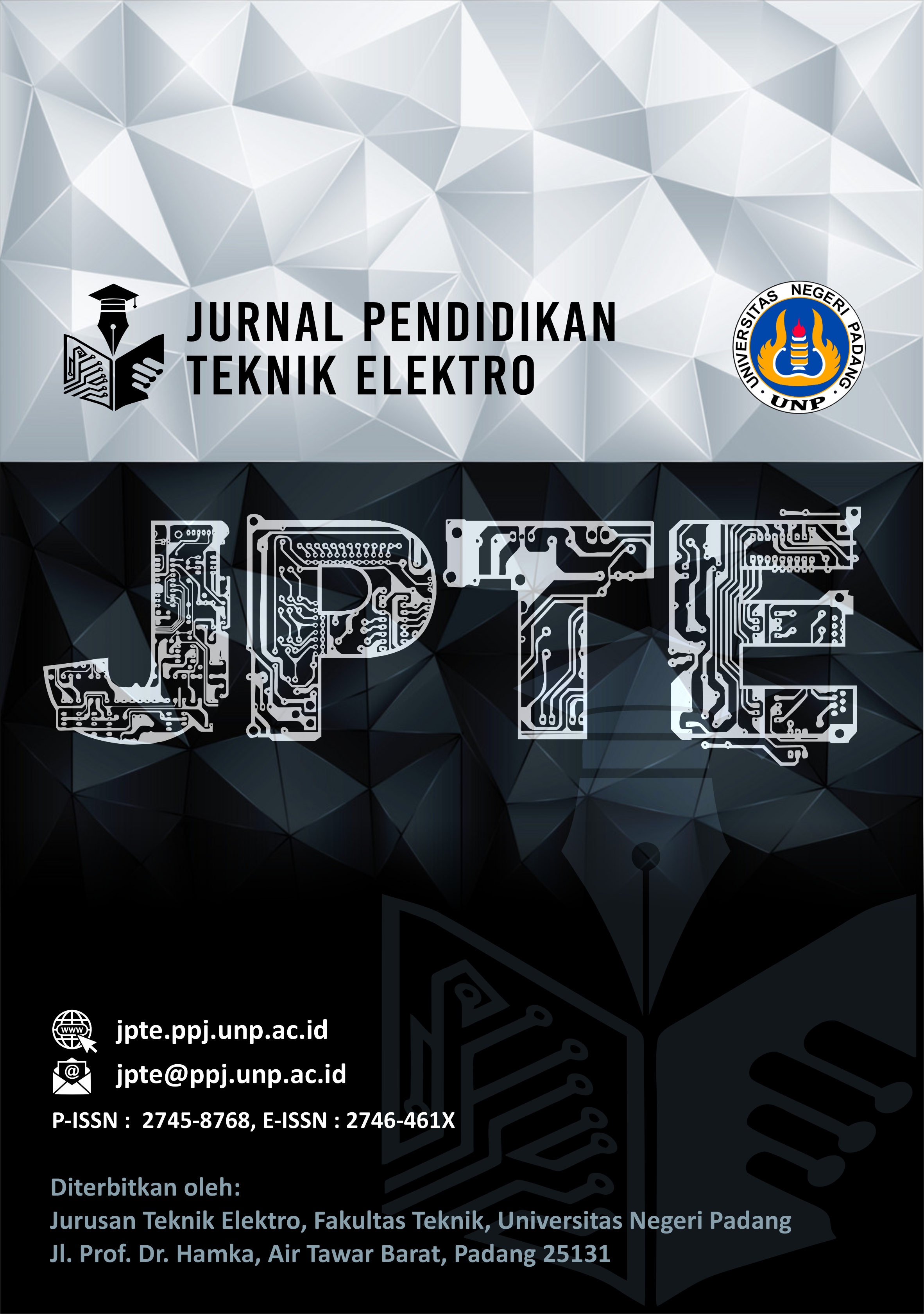Perbedaan Hasil Belajar Mahasiswa Teknik Elektro dalam Mata Kuliah Mesin-Mesin Listrik Ditinjau dari Jalur Masuk dan Latar Belakang Pendidikan
##plugins.themes.academic_pro.article.main##
Abstract
Learning outcomes are an indicator of the mastery of lecture material that students have achieved. Learning outcomes can be used as a benchmark for student success in lectures. This research aims to describe differences in learning outcomes in the Electrical Machines Course for Electrical Engineering students entering 2020. The type of research that the author conducted was descriptive comparative research. Data collection was carried out using documentation instruments obtained from the Technical Implementation Unit for Data and Technology Services, Padang State University in the form of learning outcomes for the Electrical Machines Course, entry selection routes, and educational background of Electrical Engineering Education students entering 2020. It can be concluded that there is no significant difference in learning outcomes for the Electrical Machines course in terms of the SNMPTN, SBMPTN and Independent Selection entry groups. Where the highest average is students from the Independent Selection route and the lowest average is students from the SNMPTN route. Based on educational background, there are also no significant differences between SMK, SMA, and MA. Where the highest average score is for students with an MA education background and the lowest average is for students with a vocational school education background.
##plugins.themes.academic_pro.article.details##

This work is licensed under a Creative Commons Attribution 4.0 International License.
References
[2] C. Antonietti, A. Cattaneo, and F. Amenduni, “Can teachers’ digital competence influence technology acceptance in vocational education?,” Comput Human Behav, vol. 132, p. 107266, Jul. 2022, doi: https://doi.org/10.1016/J.CHB.2022.107266.
[3] M. Korber and D. Oesch, “Vocational versus general education: Employment and earnings over the life course in Switzerland,” Adv Life Course Res, vol. 40, pp. 1–13, 2019, doi: https://doi.org/10.1016/j.alcr.2019.03.003.
[4] H. Habe and A. Ahiruddin, “Sistem Pendidikan Nasional,” Ekombis Sains: Jurnal Ekonomi, Keuangan dan Bisnis, vol. 2, no. 1, pp. 39–45, 2017, doi: 10.24967/ekombis.v2i1.48.
[5] D. T. P. Yanto, M. Kabatiah, H. Zaswita, G. Giatman, and H. Effendi, “Development of Virtual Learning using Problem-Based Learning Models for Vocational Education Students,” ELINVO (Electronics, Informatics, and Vocational Education), vol. 7, no. 2, pp. 163–172, 2022, doi: 10.21831/elinvo.v7i2.52473.
[6] Sutrisno, Meningkatkan Minat dan Hasil Belajar TIK Materi Topologi Jaringan dengan Media Pembelajaran. Malang: Ahlimedia Press, 2021.
[7] E. S. Wahyuningsih, Model Pembelajaran Mastery Learning Upaya Peningkatan Keaktifan Dan Hasil Belajar Siswa. Yogyakarta: Deepublish, 2020.
[8] M. Fikri, N. Erizon, R. Mulyadi, and D. Y. Sari, “Hubungan Penggunaan Media Pembelajaran Video Terhadap Hasil Belajar Dasar Perancangan Teknik Mesin Siswa Kelas X Jurusan Teknik Pemesinan Smk Negeri 1 Bukittinggi,” Jurnal Vokasi Mekanika (VoMek), vol. 3, no. 3, pp. 50–57, 2021, doi: 10.24036/vomek.v3i3.208.
[9] D. T. P. Yanto et al., “Innovative Laboratory Learning: A Study Evaluating the Practicality of Integrated E-Worksheets with Augmented Reality in Electrical Machines Course,” International Journal of Information and Education Technology, vol. 14, no. 7, pp. 996–1005, 2024, doi: 10.18178/ijiet.2024.14.7.2127.
[10] S. Manual, F. Edition, and S. J. Chapman, “Fifth Edition”.
[11] T. Djudin, “Analisis Prestasi Akademik Mahasiswa Lulusan Jurusan Pendidikan Mipa Fkip Untan Ditinjau Dari Jalur Masuk (Snmptn, Sbmptn, Mandiri) Dan Program Kuliah (S-1 Reguler, S-1 Percepatan Apk),” Jurnal Pendidikan Matematika dan IPA, vol. 9, no. 2, p. 76, 2018, doi: 10.26418/jpmipa.v9i2.25867.
[12] H. Syahrizal and M. S. Jailani, “Jenis-Jenis Penelitian Dalam Penelitian Kuantitatif dan Kualitatif,” Jurnal QOSIM Jurnal Pendidikan Sosial & Humaniora, vol. 1, no. 1, pp. 13–23, 2023, doi: 10.61104/jq.v1i1.49.
[13] U. Usmadi, “Pengujian Persyaratan Analisis (Uji Homogenitas Dan Uji Normalitas),” Inovasi Pendidikan, vol. 7, no. 1, pp. 50–62, 2020, doi: 10.31869/ip.v7i1.2281.
[14] F. Annisak, H. Sakinah Zainuri, and S. Fadilla, “Peran uji hipotesis penelitian perbandigan menggunakan statistika non parametrik dalam penelitian,” Al Itihadu Junral Pendidikan, vol. 3, no. 1, pp. 105–115, 2024.
[15] Astiti Tenriawaru Ahmad, Eva Meizara Puspita Dewi, and Basti, “Prestasi Akademik Ditinjau dari IQ dan Jalur Masuk Perguruan Tinggi Mahasiswa Psikologi Universitas Negeri Makassar,” Seminar Nasional Dies Natalis 62, vol. 1, pp. 270–278, 2023, doi: 10.59562/semnasdies.v1i1.816.
[16] P. M. Wening and A. Nurkin, “Pengaruh Kemandirian Belajar Terhadap Prestasi Akademik Dengan Latar Belakang Pendidikan Sebagai Variabel Covarian Pada Mahasiswa Jurusan Pendidikan Ekonomi Universitas Negeri Semarang,” Business And Accounting Education Journal, vol. 3, no. 3, pp. 330–346, 2022, doi: 10.15294/baej.v3i3.59828.
[17] E. Mardita, “Analisis Prestasi Akademik Mahasiswa Teknik Elektro Ditinjau dari Latar Belakang Pendidikan dan Jalur Masuk,” vol. 05, no. 02, pp. 373–379, 2024.
[18] S. Mona and P. Yunita, “Faktor-Faktor yang Berhubungan dengan Prestasi Belajar Mahasiswa,” Menara Ilmu, vol. 15, no. 2, pp. 117–125, 2021.

